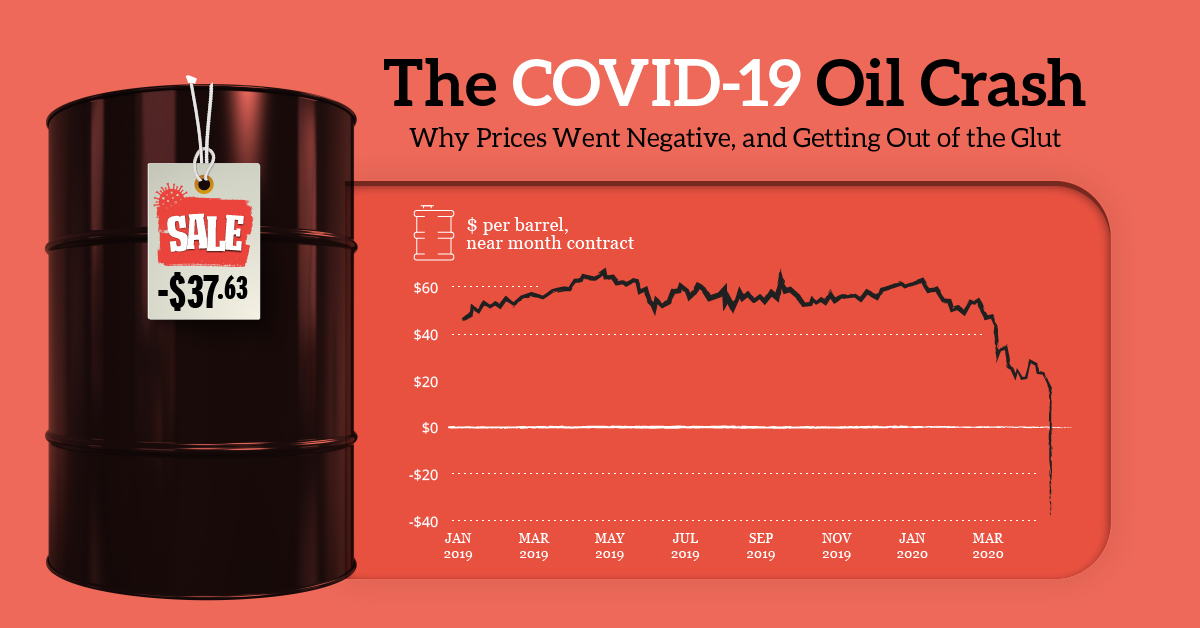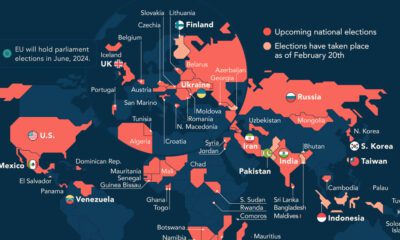Energy
How Oil Prices Went Subzero: Explaining the COVID-19 Oil Crash

Explaining the Historic COVID-19 Oil Price Crash
The Great Lockdown continues to turn markets on their head.
Last week, we dug into the unprecedented number of initial jobless claims coming out of the United States, which topped 22 million in a period of four weeks.
It’s just days later, and we already have our next market abnormality: this time, traders were baffled by West Texas Intermediate (WTI) crude — the U.S. benchmark oil price — which somehow flipped negative for the first time in history.
How is that possible? And how does it tie into the COVID-19 oil price crash in general?
Setting the Geopolitical Stage
Oil is a geopolitical game, and big price swings always come with a geopolitical undercurrent.
This particular story picked up steam in February as OPEC+ producers tried to negotiate a production cut, amid concerns that COVID-19 could impact demand. Russia walked out on these meetings, and Saudi Arabia responded by undercutting oil prices by $6-8 per barrel.
The world went into lockdown, energy demand dissipated, and oil producers continued to pump at will. Then on April 9th, nearly a full month after COVID-19 was declared a pandemic, Russia and Saudi Arabia finally settled their differences.
However, this truce came too late — prices had already fell about 60% from February highs.
How Prices Went Subzero
Up until recently, this was a fairly run-of-the-mill oil price crash — but then prices suddenly sunk below zero, with May futures for WTI oil closing at -$37.63 on April 20th.
For the first time in history, producers were willing to pay traders to take oil off their hands. This oddity is partially a function of the particularities of futures contracts:
- Buyers Wanted (At Any Cost!)
Futures contracts normally rollover to the next month without much happening, but in this case traders saw the May contract as a “hot potato”. No one wanted to be stuck taking delivery of oil when the world is awash in it and the country is in lockdown. - A Time and a Place
Oil futures contracts specify a time and place for delivery. For WTI oil, that specific place is Cushing, Oklahoma. With most storage capacity booked already, taking physical delivery wasn’t even an option for many players.
In other words, sellers outnumbered buyers by a crazy margin — and because oil is a physical commodity, someone has to ultimately take the contract.
At time of publishing, the May contract and spot prices have “rebounded” to about $10. The June contract is slightly higher, at $13.
“Never before has the oil industry come this close to testing its logistics capacity to the limit.”
– International Energy Agency (IEA), Oil Market Report for April
Overcoming the Supply Glut
What do you do when oil is practically free?
You store as much of it as you can, and hope that at some point you can sell it for more.
Unfortunately, everyone has the exact same idea, and as a result there is a historic glut that is filling up the world’s storage capacity both on land and at sea:
- In March, it was estimated that 76% of the world’s available oil storage capacity was already full.
- A record-setting 160 million barrels of oil is being stored on tankers at sea, according to Reuters.
- The cost of renting an oil supertanker has gone through the roof. It’s jumped from $20,000 per day to $200,000-$300,000 per day, according to Rystad Energy.
It remains to be seen how fast the transportation industry will recover in a post-COVID-19 world, but for now the outlook for all oil producers is grim. The continued fallout will not only affect industry, but also the countries that rely on oil exports to balance their budgets.
Energy
The World’s Biggest Nuclear Energy Producers
China has grown its nuclear capacity over the last decade, now ranking second on the list of top nuclear energy producers.

The World’s Biggest Nuclear Energy Producers
This was originally posted on our Voronoi app. Download the app for free on Apple or Android and discover incredible data-driven charts from a variety of trusted sources.
Scientists in South Korea recently broke a record in a nuclear fusion experiment. For 48 seconds, they sustained a temperature seven times that of the sun’s core.
But generating commercially viable energy from nuclear fusion still remains more science fiction than reality. Meanwhile, its more reliable sibling, nuclear fission, has been powering our world for many decades.
In this graphic, we visualized the top producers of nuclear energy by their share of the global total, measured in terawatt hours (TWh). Data for this was sourced from the Nuclear Energy Institute, last updated in August 2022.
Which Country Generates the Most Nuclear Energy?
Nuclear energy production in the U.S. is more than twice the amount produced by China (ranked second) and France (ranked third) put together. In total, the U.S. accounts for nearly 30% of global nuclear energy output.
However, nuclear power only accounts for one-fifth of America’s electricity supply. This is in contrast to France, which generates 60% of its electricity from nuclear plants.
| Rank | Country | Nuclear Energy Produced (TWh) | % of Total |
|---|---|---|---|
| 1 | 🇺🇸 U.S. | 772 | 29% |
| 2 | 🇨🇳 China | 383 | 14% |
| 3 | 🇫🇷 France | 363 | 14% |
| 4 | 🇷🇺 Russia | 208 | 8% |
| 5 | 🇰🇷 South Korea | 150 | 6% |
| 6 | 🇨🇦 Canada | 87 | 3% |
| 7 | 🇺🇦 Ukraine | 81 | 3% |
| 8 | 🇩🇪 Germany | 65 | 2% |
| 9 | 🇯🇵 Japan | 61 | 2% |
| 10 | 🇪🇸 Spain | 54 | 2% |
| 11 | 🇸🇪 Sweden | 51 | 2% |
| 12 | 🇧🇪 Belgium | 48 | 2% |
| 13 | 🇬🇧 UK | 42 | 2% |
| 14 | 🇮🇳 India | 40 | 2% |
| 15 | 🇨🇿 Czech Republic | 29 | 1% |
| N/A | 🌐 Other | 219 | 8% |
| N/A | 🌍 Total | 2,653 | 100% |
Another highlight is how China has rapidly grown its nuclear energy capabilities in the last decade. Between 2016 and 2021, for example, it increased its share of global nuclear energy output from less than 10% to more than 14%, overtaking France for second place.
On the opposite end, the UK’s share has slipped to 2% over the same time period.
Meanwhile, Ukraine has heavily relied on nuclear energy to power its grid. In March 2022, it lost access to its key Zaporizhzhia Nuclear Power Station after Russian forces wrested control of the facility. With six 1,000 MW reactors, the plant is one of the largest in Europe. It is currently not producing any power, and has been the site of recent drone attacks.
-

 Real Estate2 weeks ago
Real Estate2 weeks agoVisualizing America’s Shortage of Affordable Homes
-

 Technology1 week ago
Technology1 week agoRanked: Semiconductor Companies by Industry Revenue Share
-

 Money1 week ago
Money1 week agoWhich States Have the Highest Minimum Wage in America?
-

 Real Estate1 week ago
Real Estate1 week agoRanked: The Most Valuable Housing Markets in America
-

 Business2 weeks ago
Business2 weeks agoCharted: Big Four Market Share by S&P 500 Audits
-

 AI2 weeks ago
AI2 weeks agoThe Stock Performance of U.S. Chipmakers So Far in 2024
-

 Misc2 weeks ago
Misc2 weeks agoAlmost Every EV Stock is Down After Q1 2024
-

 Money2 weeks ago
Money2 weeks agoWhere Does One U.S. Tax Dollar Go?















